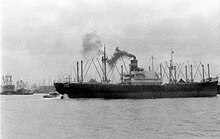C3 ship
The C3 type of general cargo ship, or simply C3 freighter , was a type of serial cargo ship that was built at various shipyards in the United States during World War II . 165 copies of this type of ship were made between 1939 and 1947.
history
The C3 freighter, constructed in the late 1930s, came from the Long Range Shipbuilding Program of the United States Maritime Commission (MARCOM). The US authority MARCOM first presented a basic draft to the shipyards, shipbuilding engineers and shipping companies. The final design represented a relatively fast type of ship, which with a speed of 16.5 knots could be used as an auxiliary ship in the event of war. The first two prototypes were finally built from 1939 onwards, taking into account the suggestions for improvement. The standardization of the design and the built-in components made it possible to achieve a favorable construction price, which, in particular in connection with the state aid granted to the operator, could compete with comparable designs from other shipbuilding countries. The C3 type ship was the exporter delivered on September 28, 1939 .
The basic design had five holds and a load capacity of about 12,500 tons. The standard ships had a length of almost 150 meters, a width of 21.2 meters and a draft of 8.7 meters (later C3 ships had partly different dimensions). Most of the hulls were partly welded and partly riveted in a composite construction. With the few completely welded ships, up to 600 tons of steel structure could be saved. Since the average construction time of the comparatively complex pre-war construction was around 190 days, a large part of the shipbuilding in this segment concentrated on the easier and faster to produce Liberty ships during the course of the war .
The majority of the C3-vessels was powered by a General Electric - steam turbine plant , which was supplied by two Foster-Wheeler boilers with steam and their 6250 kW gave to the propeller through a two-stage gear reduction. The fastest versions reached speeds of up to 19 knots in the shipyard test drives. The alternative was a geared motor system with four plunger motors and a maximum propeller speed of 85 / min.
The nautical equipment included a gyro compass . The superstructures arranged amidships offered better comfort on three decks compared to older types of ships.
C3 ships were delivered to the shipping companies American Export Lines , Seas Shipping, American South African Line, Four Aces, American President Lines and Moore-McCormack Lines , among others . The C3 types were used as commercial cargo ships until the 1970s.
During the Second World War , a large number of C3 freighters from the US Navy used and by the United States Maritime Service. The conversions to escort aircraft carriers of the Charger class and Bogue class are to be emphasized .
Individual evidence
- ↑ Ship data on Miramar (English) ( page no longer available , search in web archives ) Info: The link was automatically marked as defective. Please check the link according to the instructions and then remove this notice.
literature
- Lane, Frederic Chapin: Ships for Victory: A History of Shipbuilding under the US Maritime Commission in World War II . Johns Hopkins Press, Baltimore 2001, ISBN 0-8018-6752-5 .
- Sawyer, LA; Mitchell, WH: From America to United States . The History of the long-range Merchant Shipbuilding Program of the United States Maritime Commission. World Ship Society, London 1981, ISBN 0-905617-12-6 (or ISBN 0-905617-31-2 or ISBN 0-905617-38-X ).
- Zuidhoek, Arne: Schip van de eeuw . De Liberty, Victory, C3 en alle verdere standardschepen onder nederlandse flag - WW II-standard ships flying the colors of the Netherlands. Uitgeverij de Fontein, Baarn 2001, ISBN 90-261-1743-4 .

